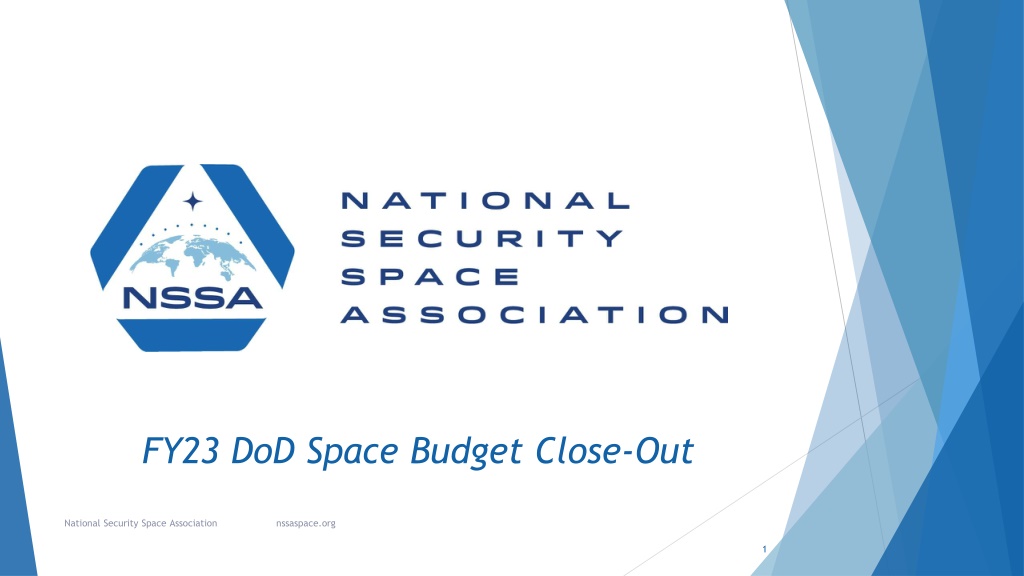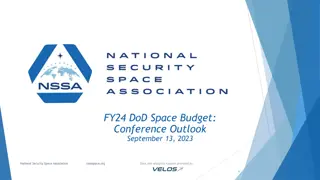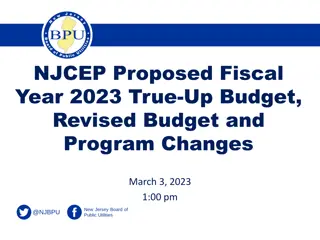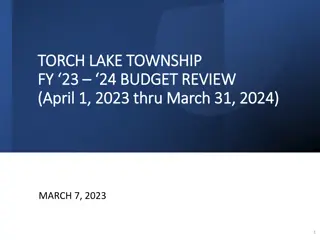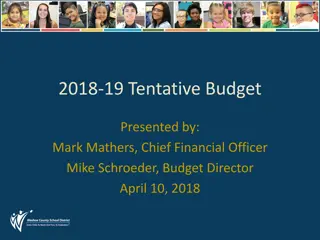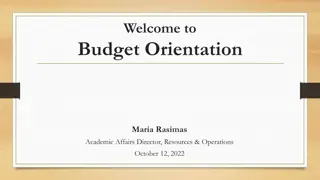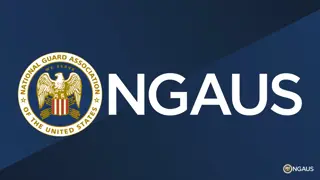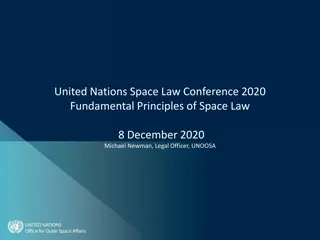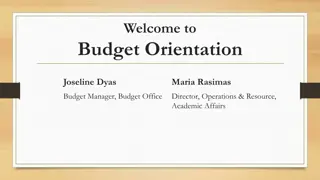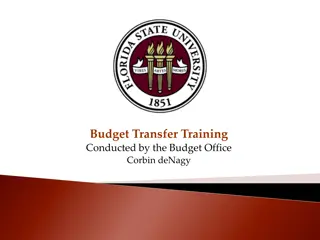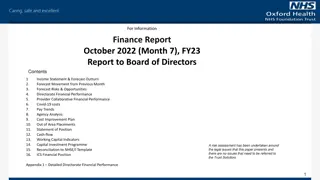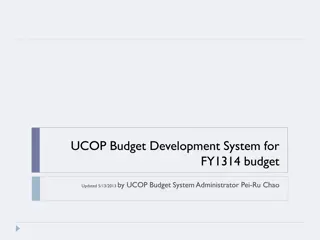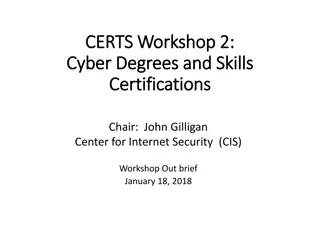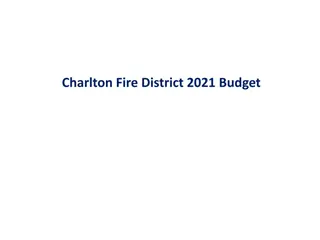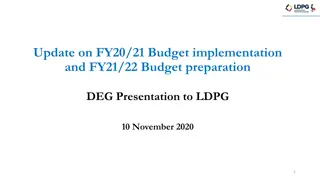FY23 DoD Space Budget Overview and Investments
The FY23 Department of Defense (DoD) budget continues to prioritize investments in national security space capabilities, with a $1.6B increase in funding for DoD space programs. The United States Space Force receives significant appropriations exceeding the request, emphasizing oversight and management. The budget distribution includes boosts for Advanced R&D, Space Development Agency, Assured Access to Space, and classified programs, while making cuts in certain areas to align with strategic priorities. Additionally, there are realignments and adjustments in funding for projects like Next-Gen OPIR and Space Sensing initiatives. Overall, the emphasis is on enhancing capabilities, ensuring resiliency, and maximizing operational efficiency in the space domain.
Download Presentation

Please find below an Image/Link to download the presentation.
The content on the website is provided AS IS for your information and personal use only. It may not be sold, licensed, or shared on other websites without obtaining consent from the author. Download presentation by click this link. If you encounter any issues during the download, it is possible that the publisher has removed the file from their server.
E N D
Presentation Transcript
FY23 DoD Space Budget Close-Out National Security Space Association nssaspace.org 1
DoD Space Budget In FY23 Congress continued trend of increased investment into DoD space capabilities Grows funding for DoD Space programs by $1.6B (6%) over the request Continued consolidation of space program funding with the United States Space Force budget USSF only service to be appropriated funds in excess of request (space programs) FY23 National Defense Authorization Act (NDAA) again prioritizes oversight of the organization and management of the USSF and its component entities
USSF Budget by Portfolio * Funding increase for USSF dispersed throughout the mission portfolios Major increases for Advanced R&D, Space Development Agency, Assured Access to Space and Classified programs Minor cuts to MILPERS and BMC3 programs Increased funding for USSF complemented by additional oversight of architecture developmentand management of the USSF space portfolio * - USSF assumed budget responsibility for SDA in FY23 therefore previous years reflect zero in USSF budget accounting; SDA Funding in previous 2 years- FY21: $257.9M; FY22: $1,462.9M - blue rows in the table above align to SSC s PEO organizational structure
Space Sensing Major realignment of Next-Gen OPIR funding across four PEs: Next-Gen OPIR, Ground, GEO and Polar (requested by DAF) Cuts $145M from MW/MT programs due to delays or inadequate justifications for mission data processing, Space Modernization Initiative and MEO ground efforts Additional adds: +$65M for on-board resiliency and +$130M for Resilient MW/MT MEO epoch 1 acceleration Strong oversight language and reporting requirements on MW/MT investments: concern over insufficient information on life-cycle costs, supply chain risks and operational impacts CAPE, SECAF and CSO required to provide reviews and briefings on MW/MT architecture EO/IR Weather Systems cuts FY23 funding (-$10M) and rescinds FY22 funding (-$35.4M) for Phase III product development request being excess to need
Space Development Agency Major acceleration of launch funding for SDA: total add of +$432M to procurement for technical realignment requested by DAF (+$216M) and to accelerate launch of MW/MT capabilities per USSPACECOM UFR (+$216M) Continued investment into INDOPACOM missile tracking demonstration: +$250M in FY23 ($500M in FY22 appropriations) Additional adds for: tranche 1 space resiliency payloads, experimental testbed, and laser communication downlink systems Also includes minor program reduction (-$26M) for follow-on tranches NDAA oversight provisions include a review of SDA exemption from Joint Capabilities Integration and Development System (JCIDS) and strong guidance to permanently allocate three SES positions to the SDA * - USSF assumed budget responsibility for SDA in FY23; FY21 & FY22 reflect funding within OSD account
Assured Access to Space Funds three NSSL launches in FY23 and provides +$80M for NSSL payload processing facility and +$30M for space mobility and logistics NDAA provides extensive guidance and direction regarding congressional intent for the NSSL Phase III acquisition strategy, including oversight and reporting requirements Appropriations bill provides clear direction to use NSSL Phase Two contract unless deviation is certified to Congress and justified adequately Continues congressional support for Tactically Responsive Launch, including +$50M and direction to fund the program across the FYDP; additional NDAA requirements including collaboration with allied partners on responsive space initiatives Also includes +$15M for state launched range services and capabilities under the Rocket Systems Launch Program (RSLP)
Communications & PNT Cuts -$52M from Protected Tactical Service/Protected Tactical Enterprise Service (PTES) for unjustified or excess costs Cuts -$45M from Evolved Strategic SATCOM (ESS) for unjustified or excess costs Cuts -$55M from Narrowband Satellite Communications (MUOS RDTE) for service life extension delays Airdrops +$442M in procurement for an additional protected wideband spacecraft under the WGS program; no committee had included this add in any of the preceding marks akin to FY18 omnibus (+$600M for WGS 11/12); also required to develop plan for launch and O&M costs Cuts -$155M from GPS-III across procurement and RDTE lines for unjustified or excess costs but provides sufficient funds for planned procurement of two GPS-III follow-on satellites
BMC3 Minor cut (-$5.5M) to AFSCN procurement due to insufficient justification Fully funds Enterprise Ground Services NDAA requires SECAF update plan on Integrated Tactical Warning and Attack Assessment System (ITW/AA) in coordination with Army, Navy, MDA, NRO and SDA
SDA & CP Cuts -$9M from the Deep Space Advance Radar Concept (DARC) to reduce cost growth Cuts -$8M from SILENTBARKER, the SBSS Follow-On for management services being excess to need Increases funding +$10M for the Space Security and Defense Program (SSDP), +$8M for the Ground Based Optical Sensor System (GBOSS) for AI and autonomy and +$10M for Unified Data Library NDAA requires report on threats posed by made-made space debris in LEO
Advanced R&D Space Technology RDTE lines received +$200M from 25+ separate technology development adds across the space mission areas Projects include: L-Band active phased array demo; flexible solar panels; lunar surface based space domain awareness; and advanced space power systems Creates new USSF RDTE lines for basic research (+$25M) and University Research Initiatives (+$30M) Allows SECAF and CSO in coordination with CTO tocarry out applied research and educational activities to advance capabilities related to: space domain awareness, PNT, Comms, Hypersonics, Cybersecurity and other matters Notes space unique capabilities executed out of AFRL/SV are more appropriately budgeted in the USSF RDTE account to enhance alignment
Organizational Investments Fully funds Space Warfighting Analysis Center (SWAC), SSC Workforce and National Space Defense Center (NSDC) Provides +$9M for Space Rapid Capabilities Office for hyper-converged edge computing Notes budget projections are anticipated to remain flat and declining over the next 5 years; mismatch between program scope and overall budget resources raises concerns about the degree to which serious analysis or long-term planning has been done to assess the realism and affordability of its portfolio or programs Directs a briefing on the projected cost, affordability, and executability of the full portfolio of programs and activities funded in the Space Force accounts, including supporting analysis, assessment of risks, and risk management plans NDAA requires comprehensive strategy for the Space Force: from OTE objectives, funding/infrastructure/architecture plans, to establishing directing reporting units (DRU) and/or field operating agencies (FOA)
MILPERS Establishes the total number of active duty commissioned officers serving in the Space Force in the grades of major, lieutenant colonel, and colonel Grants the Secretary of the Air Force the authority to vary the end strength of the Space Force from the number authorized by Congress by an increase of not more than 5 percent or a decrease of not more than 10 percent Requires SECAF and CSO review of the manning required to fully staff the current and planned cyber squadrons of the Space Force; consideration of sourcing billets, administration process, responsibilities of civilian and military personnel, and benefits and risks Directs research activities should promote education and training for students to support the future national security space workforce of the United States and to explore opportunities for international collaboration
Classified Includes +$500M in adds to classified USSF RDTE programs Consistent support from Congress on classified space programs in recognition of threat environment and sense of urgency
O&M Increases investment into Space Force Education & Training: +$11M for cyber skills training and +$15M to expand space training courses and capacity Additional funding for Facilities Sustainment, Restoration and Modernization including +$20M for Cheyenne Mountain Complex and +$28M to upgrade training facilities for security classification
FY24 Preview FY24 Budget Request to be released March 9 Expected to continue the trend of a substantial increase to the USSF topline Where will those increased investments reside? How much of a FY24 increase was projected in FY23 vs. new money in FY24? How much of an FY24 increase will be attributed to: Classified programs? MW/MT? Launch? How responsive is DoD/USSF to congressional guidance on budget fidelity, rigorous analysis and cost/schedule realism? Has DoD/USSF done a better job of showing their work ? Is there any evidence of new investments into integration of commercial capabilities for launch, space sensing, communications, etc.? Have any additional funds transferred into USSF from other services?
